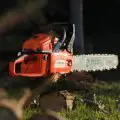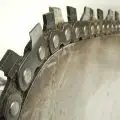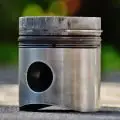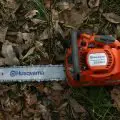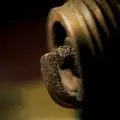The ideal scenario would be for the chain to cease turning once you’ve finished using the chainsaw and let go of the throttle. What if it kept turning around the bar and didn’t stop?
If it doesn’t, you run the risk of breaking anything or gravely hurting someone if you make a bad move, like turning around too rapidly. The issue might be resolved with a quick carburetor adjustment. If not, it can indicate that the clutch doesn’t disengage. Typically, that means the clutch has to be changed.
It demonstrates how crucial a chainsaw is and how it should be handled properly and with the respect it is due. Even when you frequently maintain it, a number of unforeseen events, whether they be unintentional or environmental, may have an impact.
In this article, we’ll discuss all the possible causes of chainsaw races at idle, along with fixes so that you can get back to work without worry!
Table of Contents

Chainsaw Races at Idle: Causes & Fixes
- Bad/old gas mixture
- Clogged air filter
- Dirty spark plugs
- Clogged or leaking primer bulb
- Idle screws not adjusted properly
- Clutch malfunction
The chainsaw engine should preferably be in idle mode when you turn it on. And then watch to see if the clutch engages. After that, it will power the gears and sprockets, allowing the chain to turn. If it doesn’t idle and goes races straight into full throttle, you likely have one of these issues listed.
While on the topic of idling, visit our Chainsaw Won’t Idle? Causes & Fixes When Your Chainsaw Won’t Stay Running guide!
Now, let’s take a look at why your chainsaw is racing at idle in more detail!
Bad/Old Gas Mixture
Any fuel that is still in the tank of your saw after it hasn’t been used for a long while will cause issues with the filter and fuel line. It will cause congestion or gumming up. As a result, when hot, the chainsaw won’t idle.
Higher quantities of ethanol prevent gasoline with lower octane from keeping its freshness for very long. and will result in its seal corroding. Additionally, the fuel you bought from the local gas station will have a dirty tank and dangerous sediment at the bottom.
Whatever the cause, you may remove bad gas from the tank using a siphon and replace it with new, clean gasoline. For long-lasting, clean-burning gas, experts advise using a fuel with an octane rating of at least 89 premium.
Clogged Air Filter
A standard gas-powered chainsaw relies on the proper operation of a two-cycle air-cooled engine. If dust and sawdust are present in the air, the filter will become clogged and compromised. The dust coupled with the oil used to lubricate the saw may further clog the filter and prevent fluid from passing through the dirty air filter system.
It has the convenience that you can remove them quickly. You can either wash it out with strong detergent soap and water or use compressed air to blow any dirt or grime off of it.
Dirty Spark Plugs
Your chainsaw’s spark plug will clog if the fuel is contaminated or aged. It will then start to get gummy and sticky, which will ruin its engine. The carbon-coated surface of a fouled spark plug can be removed by cleaning or replacing it.
Fortunately, a spark plug is very inexpensive, but you must make sure you purchase the correct one for your saw because different models require different spark plugs.
Checking the spark plug gap will help your saw because it will eventually be at risk. Additionally, it will be helpful for you to maintain a replacement plug on hand so that you may swap it out if necessary.
Clogged or Leaking Primer Bulb
If the saw you have has a priming bulb, after time it may accumulate fuel and oil buildup and turn gummy. Additionally, it may deteriorate the seal and cause microscopic slits that allow an air leak to occur.
It denotes poor airflow and excessive air ingestion into the saw’s engine, which limits the saw’s capacity to run at an idle speed. You will need to replace your primer bulb in this case.
Idle Screws Need Adjusting
The air passage into the engine is made possible by these screw types. Most chainsaw models include pre-adjusted screws, therefore they do not require fine-tuning. However, to make your carburetor work properly, you must adjust these screws.
Too much air passing through the engine will cause your saw to run too rich (rich fuel mixture), causing it to smoke, have insufficient power, malfunction in your idling setting, and cause a variety of other problems.
Visit our Chainsaw Smoking When Cutting & Husqvarna Chainsaw Smoking When Cutting? guides for more information on chainsaws smoking!
All of the carbon will accumulate and clog the other components, causing more problems. When an engine runs lean, not enough air is flowing through it, which results in weak power and a hot saw as a whole. Any of these could cause an engine seizure in a tour chainsaw.
How to Adjust Carburetor Screws
The majority of chainsaw models include three adjustable screws: one to change the chainsaw’s high speed (high-speed screw), another to change the chainsaw’s low speed (low-speed screw), and a third to change the idling or throttle (idle/throttle screw). These screws control how, when the trigger is released, the throttle valve remains open.
When the throttle is released while the chainsaw’s engine is set to a low speed, the engine will shut off. If the speed is idle or high, the chainsaw chain will run continually, raising safety issues.
The letter L for low is marked on the adjustment for the low-speed adjustment screw. It controls how much air is mixed with the gas when it is running at idle. Whether you twist it too high or too low is irrelevant. The engine will stop running at idle speed as a result.
The setting for high speed controls the fuel and air ratios at sawing speed and has an H indication for high-speed adjustment screw. Its engine won’t reach its maximum power in RPM or revolutions per minute if the ratio for both is too rich. If the adjustment is made too lean, the engine could fail, seize up, run hot, and lack power.
These kinds of screws must only be adjusted delicately and with the utmost care. Your saw will operate correctly if you don’t tighten them up too much. Gently screw each one in to start the adjustment process, and make sure there is only one click moving backward. Make sure the chainsaw’s fuel tank is roughly half full before starting it up, and that the filters are clean.
Allow the saw to run in idle mode for a while after turning it on to warm up the engine. You can accomplish this by continuously tightening and loosening the idle screw. Set the idle mode to the highest lever after the engine has warmed up, but before you engage the clutch.
Turn the screw slowly until the chainsaw engine is gas-starved, then slowly again until it has loaded up to the desired low-speed setting. Adjust it a few more times until the middle of the setting, where it sounds good, is reached.
Return to the idle screw and adjust it as well. Back and forth between the two until you believe it is functioning properly. You won’t need to adjust the high-speed screw if you can master the other two.
Clutch Malfunction
If the chainsaw’s functionality appears to be unaffected, you can eliminate all but one of the potential sources of the chain’s issue: the clutch. A centrifugal clutch is built inside a chainsaw and is intended to only engage the chain sprocket and the motor when the throttle is depressed.
According to Repair Clinic, the clutch shoes are forced out to make contact with the clutch drum by the centrifugal force produced as the engine spins; when the engine stops, a set of springs pull the shoes back in. The shoes are either jammed or the springs are broken, which is why the clutch won’t retract and the chain keeps spinning.
Clutch Maintenance
The chain sprocket must be removed in order to service the clutch, but doing so might be challenging because the screw holding it in place is located in the center and cannot be twisted without turning the sprocket.
In order to stop the piston and engine flywheel from rotating, the spark plug must be removed and a piece of nylon rope placed within the piston cylinder. You might be able to free the locked brake shoes or replace the broken springs after removing the sprocket.
However, the simplest and most efficient fix is typically just to unscrew the brake shoes from the flywheel and change them.
Maintenance is ever-so-important, for more information and tips, visit our Chainsaw Bar Upkeep and Maintenance guide!
Here are a couple of YouTube demonstrations on the topic, focused on Stihl chainsaws:
FAQs (Frequently Asked Questions)
Why does my chainsaw run full throttle?
The chances are high that you have the carburetor adjustment screws set incorrectly. The issue might be resolved with a quick carburetor adjustment. If not, it can indicate that the clutch doesn’t disengage. Typically, that means the clutch has to be changed.
What does the throttle interlock do on a chainsaw?
This stops a brush or a stick from accidentally turning on the throttle before the operator is prepared.
How long does it take to idle a chainsaw?
A minute is sufficient, but not any less so when it’s chilly weather. The cylinder and head benefit from proper heat saturation before high revs because they idle well. It’s a good practice to start the saw, allow it to reach idle, set it down on a flat surface, and complete any other preparation you need to do for approximately a minute before grabbing the saw and turning it on at full power. Do not immediately begin operating it at full throttle.

